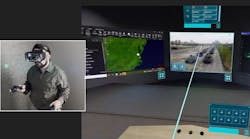Verkada announced Tuesday it has developed an integration with security operations company HiveWatch for video and access control, which is likely only the first step in partnerships between the two companies.
The integration will give Verkada more solutions for the enterprise market via HiveWatch’s Global Security Operations Center (GSOC) operating system and allow customers to bridge the gap between existing investments in legacy infrastructure and the purchase of new Verkada hardware.
HiveWatch users will be able to utilize Verkada’s streaming APIs to centralize management of multiple video and access control feeds without new hardware. Users will be able to stream live and alarm-related footage from Verkada cameras, along with access-related events, in a single platform alongside other existing data streams.
This could help GSOC operators and security leaders respond more quickly and efficiently to emerging incidents.
Verkada customers using HiveWatch’s platform will be able to reduce false alarms, provide performance metrics and analytics, centralize storage of security resources, streamline incident management and response, optimize communication between operators and field resources, manage guard patrols and field-reported incidents, and dispatch localized emergency response.
Linking Systems
Executives for the two companies said the integration is another example of security manufacturers using new technology to link disparate systems without requiring customers to rip out and replace legacy systems as they scale up their operations.
“The big push on my side is positioning the company and working with third parties and making us the most integrated platform possible,” says Filip Kaliszan, Verkada’s co-founder and CEO. “When you get to a place where your customers have complex operations, those integrations become critical. How do you build APIs? How do you share data, or build the correct workflows so each player can solve the piece they’re best at?”
HiveWatch is focusing on how to best equip and operationalize global security operation centers, said HiveWatch CEO Ryan Schonfeld. Although Verkada offers leading technology across different parts of the security ecosystem, global enterprise systems often have many different systems that do not integrate with each other, he says.
HiveWatch has integrations to most legacy players, but those platforms often don’t scale well for the customers, Schonfeld notes.
“One thing that COVID certainly accelerated for most organizations was a shift to the cloud. And one of the last pieces within most of those organizations is physical security,” Schonfeld says. “It’s one of the only places in some companies where you still see a physical server sitting there at a site. Solutions like Verkada are an obvious answer to that shift.
“When you've got tens of thousands of cameras across your ecosystem, and you’ve got a hundred thousand access control doors and all these different components, that shift can’t happen overnight and you need technology to help bridge that transition.”
Verkada has established integrations with Fūsus, HiveWatch, SingleWire Software and Sureview. With Fūsus, an Axon company that delivers a technology agnostic Real-Time Crime Center platform, Verkada customers can enable local law enforcement to access security cameras during an emergency situation.
With Singlewire Software, developer of mass notification and incident management solutions like InformaCast, Verkada customers can benefit from comprehensive altering capabilities across text, audio and visual channels.
And with SureView, a physical security information management solution, Verkada customers can pair their cameras to SureView’s security operations platform to radically improve their response to real-time events across their organization.
Fast Forwarding
Schonfeld notes the physical security market has had many individual point solutions that solve individual problems, and partnerships and ecosystem are what is needed to drive innovation. He believes that mentality is starting to sink in with security stakeholders.
Schonfeld says this integration in the video and access control arena is only the first of many integrations his company intends to pursue with Verkada.
“Data has never been more important at the enterprise level. I will use COVID as an example of physical security getting a seat at the table around space utilization and occupancy, whether it was for contact tracing or looking at real estate footprints and consolidation,” he says.
“The platform Verkada has built so far continues to evolve around building sensors and visitor management and even packages. All of those things have a very clear nexus to what we look at programmatically, and the data that not just the security organizations are interested in, but real estate and IT.
“We’re starting with video and access control because I’d say it’s table stakes within security. But the really impactful data comes from those other devices and sensors, and that’s what will be next for us.”
Kaliszan say the semantic understanding that a computer has of what's going on in the physical world is about to “go through the roof” with artificial intelligence.
“I think that's another reason that you want to start thinking about integrations and workflows because some of them will drive physical security use cases,” he says. “Some of them will probably drive other use cases and other workflows in those buildings. And that's just exciting, right? It just enables the customer to do more with their investment in the platform.”
John Dobberstein is managing editor of SecurityInfoWatch.com and oversees all content creation for the website. Dobberstein continues a 34-year decorated journalism career that has included stops at a variety of newspapers and B2B magazines.



